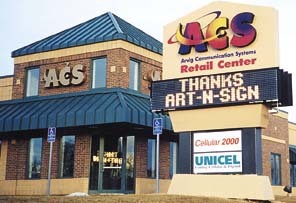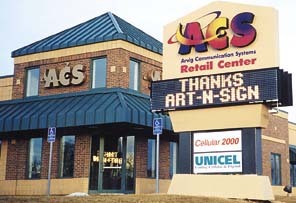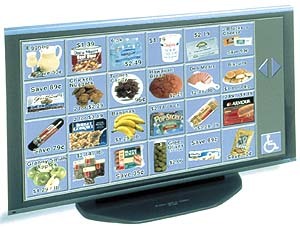The start of football season reminds us that a growing number of public sports stadiums have adopted private corporations’ names. Licensing stadium titles represents only the tip of the iceberg, however, as advertisers aggressively seek new ways to eliminate promotional barriers, such as TVs that automatically delete commercials. But, in the process, the borders between information, entertainment and advertising become increasingly blurred.
Pixels for sale
Since the advent of television, video screens have functioned primarily as information and entertainment spaces during normal programming. Today, however, marketers have begun dividing the matrix of a program image into saleable segments like those on this magazine’s advertising pages. Using software-based manipulation, producers can eliminate actual images in video feeds and replace them with artificial "enhancements." Beyond conventional doctoring of recorded videos, these techniques may now be applied to any object in the image frame of a live-camera feed.
Besides bolstering advertising opportunities, however, manipulating TV images raises ethical, political and legal questions. For example, when viewers can no longer determine whether images are real or staged, what happens to TV’s legitimacy as a source of public information? Additionally, what might be the legal ramifications of adding virtual signs to real, televised structures, or replacing real signs with virtual ones?
Compared to these potentially sticky issues, the most familiar examples of real-time image manipulation seem harmless. Networks televising National Football League games currently use virtual first-down markers superimposed onto the gridirons. This technology is produced by Princeton Video Imaging (PVI), Lawrenceville, NJ.
Baseball fans, on the other hand, may be familiar with the virtual corporate logos that frequently appear on blank wall spaces behind batters during televised games. In the near future, we can expect to see branded first-down and red-zone markers (with sponsors’ names) appearing on football fields.
Advertisement
In the autumn of 1999, CBS provided a glimpse of the brave new world of live-video tweaking during broadcasts of The Early Show. As the camera panned Manhattan’s cityscape, the CBS logo curiously appeared on buildings, billboards and elsewhere. The New York Times responded with a front-page story last January that questioned the journalistic ethics of altering televised images.
The Times’ protest might amuse the late Marshall McLuhan, former director of the University of Toronto’s Center for Culture and Technology. McLuhan believed that the television medium is inherently unsuitable for serious journalism and public discourse. He foresaw today’s blatantly self-promotional news programs more than three decades ago. An early critic of efforts to censor TV content, McLuhan strongly disputes the idea that electronic media should be evaluated by the same standards that apply to printed media.
Nevertheless, some people are concerned about potential military and political ramifications of real-time video tweaking. Steven Livingston, professor of political communication at George Washington University, recently discussed how this technology might be abused. "Imagine you are the government of a hypothetical country that wants more financial assistance," he poses. "You might send video of a remote area with people starving to death and it may never have happened."
James Currie, professor of political science at the National Defense University at Fort McNair (Washington D.C.), expressed concerns about a potential military threat. According to Currie, "The CNN effect is real. Every office you go into at the Pentagon has CNN on." Currie believes that a government or terrorist group might precipitate military action on the strength of a hoax achieved by releasing altered video.
This controversy hinges on our fundamental perceptions about television. Can TV truly be an impartial extension of the human eye, or should it be considered as an electronic canvas where producers are free to render people and objects in any desired context?
The declining popularity of TV news and political programs seems to support the latter interpretation, reinforcing McLuhan’s seminal principle that, regardless of content, the medium dictates the nature of the message. It’s no accident that this year’s national political conventions received substantially less TV coverage than those of previous presidential election years. McLuhan understood that, with few exceptions (such as the scandals surrounding Monica, Bill and OJ), reality plays poorly on TV.
Advertisement
Working it
With apologies to Walter Cronkite, it’s apparent that video screens are better suited to flights of fancy than to accurate reporting of events. This seems to explain why today’s purportedly objective TV programs rely so heavily on Hollywood tactics. But to address the concerns of those who feel threatened by televised smoke and mirrors, perhaps disclaimers should be added to discourage people from accepting what they see on video screens at face value.
Fortunately, this brouhaha should have little impact on the continued growth of the electronic-sign industry. Expanding McLuhan’s metaphor to the signage realm, this medium is the advertising message.
Sign professionals who include moving messages in their sales portfolios normally receive thanks in the form of cold cash. But sales representative Dan Combs of Art-N-Sign (Fergus Falls, MN) garnered high-profile gratitude when his company completed installation of a double-faced SunSpot1600 incandescent message board (Fig. 1) for Arvig Communication Systems (ACS), Detroit Lakes, MN. Furnished by Daktronics (Brookings, SD), the 2 x 10-ft., monochrome message center displays text and graphics in the form of 10-24-in. characters. The board operates via Daktronics’ Venus® 1500 software, giving ACS representative Carol Thunstrom the capability to instantly program messages from her IBM-compatible office computer. Daktronics Inc.$image2
Supermarket patrons can now get discount coupons without clipping their Sunday newspapers. In early June, the first MoneyBoards™ were installed at various pilot locations in South Dakota (Fig. 2). Developed by Innovative Design Technologies (IDT), Burbank, CA, and eGrocery.com (dba Grocery Shopping Network, Plymouth, MN), the MoneyBoard comprises a 42-in. plasma display manufactured by NEC America Inc. (Dallas, TX) and IDT’s software-driven touch-screen.
According to IDT’s co-owner Brett Armstrong, "Customers enter a store and walk up to a large plasma panel. All they have to do is touch the appropriate coupon and it’s printed for them."
Advertisement
This interactive system gives store managers the ability to create on-site demand for various grocery items by periodically changing coupon selections on the display. According to Michele Hopkins, eGrocery.com’s senior vice president for production, "This is the high-tech version of the blue-light special."


 Photo Gallery2 weeks ago
Photo Gallery2 weeks ago
 Ask Signs of the Times2 weeks ago
Ask Signs of the Times2 weeks ago
 Paula Fargo1 week ago
Paula Fargo1 week ago
 Real Deal6 days ago
Real Deal6 days ago
 Photo Gallery1 week ago
Photo Gallery1 week ago
 Women in Signs2 weeks ago
Women in Signs2 weeks ago
 Projects6 days ago
Projects6 days ago
 Women in Signs2 weeks ago
Women in Signs2 weeks ago

















